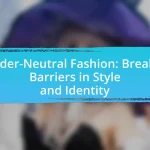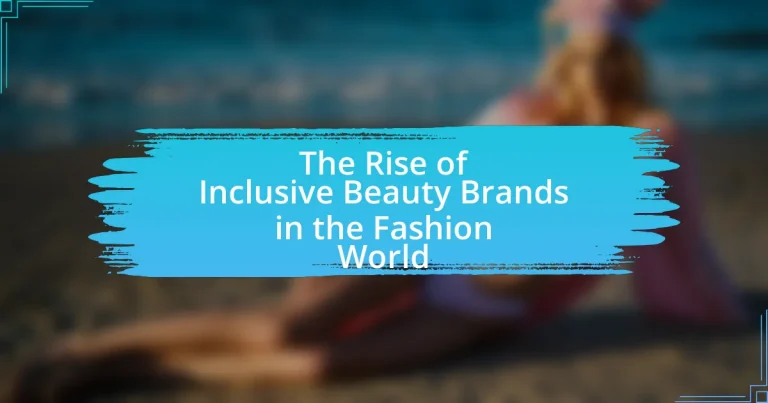The article examines the rise of inclusive beauty brands in the fashion world, highlighting their commitment to diversity and representation across various demographics. It discusses how these brands, such as Fenty Beauty, differ from traditional beauty brands by offering extensive product ranges that cater to a wide array of skin tones, body types, and gender identities. Key characteristics of inclusive beauty brands include their focus on accessibility and authentic representation in marketing. The article also explores the economic implications of inclusivity, the challenges faced by these brands, and the role of consumer demand and social media in driving their growth.
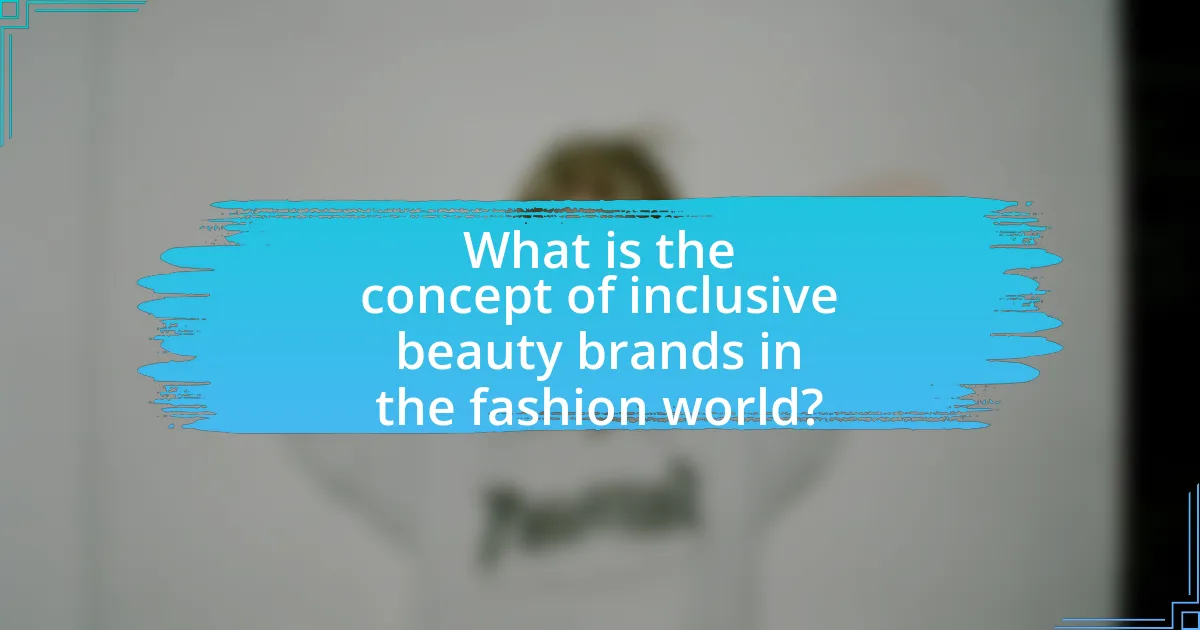
What is the concept of inclusive beauty brands in the fashion world?
The concept of inclusive beauty brands in the fashion world refers to brands that prioritize diversity and representation in their products, marketing, and overall brand ethos. These brands aim to cater to a wide range of skin tones, body types, and gender identities, ensuring that beauty products are accessible and relevant to all consumers. For instance, Fenty Beauty, launched by Rihanna in 2017, revolutionized the industry by offering 40 foundation shades, addressing the historical lack of options for darker skin tones. This approach not only enhances consumer choice but also fosters a sense of belonging and acceptance within the beauty community, reflecting broader societal shifts towards inclusivity and representation.
How do inclusive beauty brands differ from traditional beauty brands?
Inclusive beauty brands prioritize diversity and representation in their product offerings, catering to a wider range of skin tones, body types, and gender identities compared to traditional beauty brands. Traditional beauty brands often focus on a narrower demographic, typically emphasizing a limited range of shades and styles that may not reflect the diversity of the consumer base. For instance, inclusive brands like Fenty Beauty have launched extensive shade ranges, with Fenty offering 50 foundation shades to accommodate various skin tones, while many traditional brands may only provide a fraction of that. This commitment to inclusivity not only addresses the needs of underrepresented groups but also aligns with a growing consumer demand for brands that reflect social values and promote equality in beauty standards.
What are the key characteristics of inclusive beauty brands?
Inclusive beauty brands are characterized by their commitment to diversity, representation, and accessibility in their product offerings and marketing strategies. These brands typically offer a wide range of shades and formulations that cater to various skin tones, types, and concerns, ensuring that all consumers feel represented and valued. For instance, Fenty Beauty, launched by Rihanna, revolutionized the industry by introducing 40 foundation shades, addressing the needs of a diverse customer base. Additionally, inclusive beauty brands often feature models of different ethnicities, body types, and ages in their advertising campaigns, promoting a broader definition of beauty. This approach not only enhances brand loyalty but also reflects a growing consumer demand for authenticity and inclusivity in the beauty industry.
Why is inclusivity important in the beauty industry?
Inclusivity is important in the beauty industry because it ensures that products and services cater to the diverse needs of all consumers, regardless of race, gender, age, or ability. This approach not only reflects the reality of a multicultural society but also drives business growth; for instance, a study by McKinsey & Company found that companies with diverse teams are 35% more likely to outperform their competitors. By embracing inclusivity, beauty brands can tap into a wider market, foster customer loyalty, and enhance brand reputation, ultimately leading to increased sales and market share.
What factors have contributed to the rise of inclusive beauty brands?
The rise of inclusive beauty brands has been driven by increased consumer demand for diversity and representation in the beauty industry. This shift is evidenced by a 2019 report from McKinsey & Company, which found that brands that prioritize inclusivity see a 30% increase in customer loyalty. Additionally, social media platforms have amplified voices advocating for representation, leading to greater awareness of the need for products that cater to a wider range of skin tones, body types, and gender identities. The success of brands like Fenty Beauty, which launched with 40 foundation shades, demonstrates the market potential for inclusivity, as it generated over $100 million in sales within its first 40 days.
How has consumer demand influenced the growth of inclusive beauty brands?
Consumer demand has significantly influenced the growth of inclusive beauty brands by driving companies to expand their product offerings to cater to diverse skin tones and types. As consumers increasingly prioritize representation and inclusivity, brands have responded by launching wider shade ranges and products designed for various demographics. For instance, Fenty Beauty’s launch in 2017, which featured 40 foundation shades, was a direct response to consumer demand for more inclusive options, resulting in over $100 million in sales within its first 40 days. This shift in consumer expectations has prompted many established brands to reevaluate their product lines and marketing strategies, leading to a broader acceptance and growth of inclusive beauty brands in the market.
What role do social media and influencers play in promoting inclusivity?
Social media and influencers play a crucial role in promoting inclusivity by amplifying diverse voices and showcasing a wide range of beauty standards. Platforms like Instagram and TikTok allow influencers to reach vast audiences, often highlighting underrepresented groups and challenging traditional beauty norms. For instance, campaigns featuring influencers of various ethnicities, body types, and abilities have led to increased visibility and acceptance of diverse beauty, as seen in the success of brands like Fenty Beauty, which generated over $500 million in revenue within its first year by catering to a broad spectrum of skin tones. This demonstrates how social media can effectively drive inclusivity in the beauty industry, reshaping consumer perceptions and encouraging brands to adopt more inclusive practices.
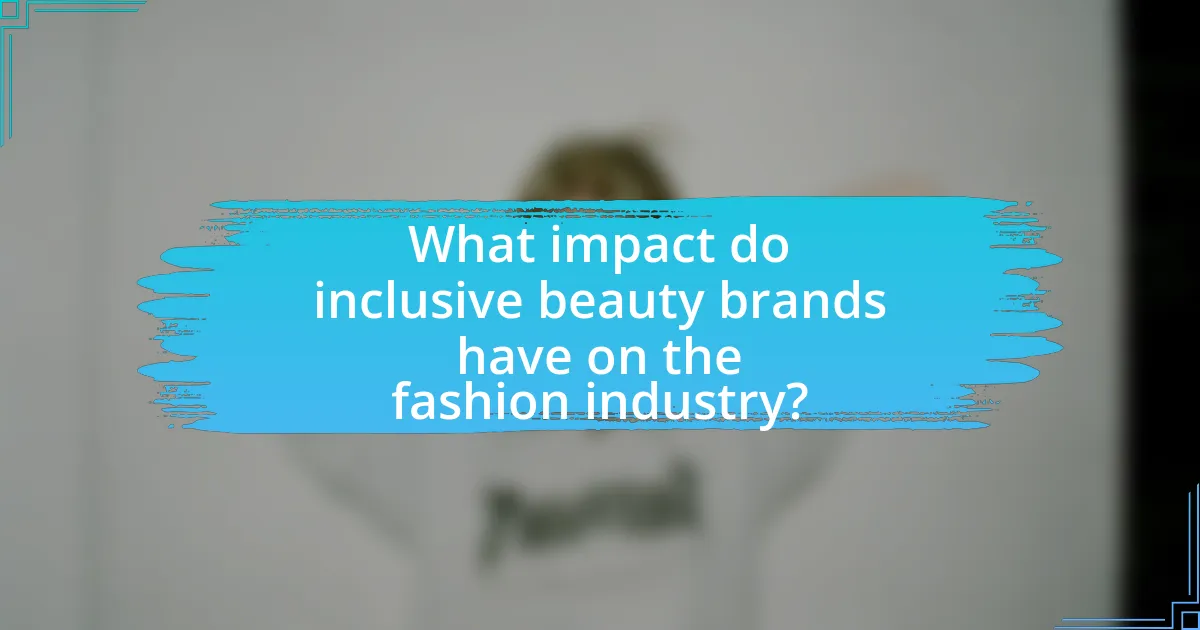
What impact do inclusive beauty brands have on the fashion industry?
Inclusive beauty brands significantly influence the fashion industry by promoting diversity and representation. These brands challenge traditional beauty standards, leading to a broader acceptance of various skin tones, body types, and gender identities within fashion. For instance, Fenty Beauty, launched by Rihanna, generated over $500 million in revenue within its first year by offering a wide range of foundation shades, which prompted other brands to expand their product lines to be more inclusive. This shift not only enhances consumer engagement but also drives sales, as consumers increasingly prefer brands that reflect their values and identities. Consequently, the rise of inclusive beauty brands fosters a more equitable fashion landscape, encouraging brands to adopt inclusive practices in their marketing and product development.
How do inclusive beauty brands challenge traditional beauty standards?
Inclusive beauty brands challenge traditional beauty standards by promoting diversity in representation, product offerings, and marketing strategies. These brands prioritize inclusivity by creating products that cater to a wide range of skin tones, body types, and gender identities, thereby addressing the limitations of conventional beauty norms that often favor a narrow definition of beauty. For instance, Fenty Beauty, launched by Rihanna, revolutionized the industry by offering 40 shades of foundation, which significantly expanded the options available for consumers of various ethnic backgrounds. This approach not only empowers individuals who have been historically marginalized in beauty marketing but also encourages other brands to adopt similar practices, thereby reshaping the overall landscape of beauty standards.
What changes have been observed in marketing strategies due to inclusivity?
Marketing strategies have increasingly shifted towards inclusivity by prioritizing diverse representation and tailored messaging. Brands now actively feature models of various ethnicities, body types, and gender identities in their campaigns, reflecting a broader spectrum of consumer identities. For instance, Fenty Beauty’s launch in 2017 included 40 foundation shades, addressing the needs of a diverse customer base and setting a new industry standard. This approach not only enhances brand loyalty but also drives sales, as evidenced by a 30% increase in revenue for brands that adopt inclusive practices.
How do inclusive beauty brands affect consumer perceptions of beauty?
Inclusive beauty brands significantly reshape consumer perceptions of beauty by promoting diversity and representation across various demographics. These brands challenge traditional beauty standards by offering products that cater to a wide range of skin tones, body types, and gender identities, thereby fostering a more inclusive definition of beauty. Research indicates that 67% of consumers believe that brands should represent a diverse range of people in their advertising, highlighting the demand for inclusivity. Furthermore, studies show that consumers are more likely to purchase from brands that reflect their own identities, which reinforces the idea that inclusive beauty brands not only enhance consumer satisfaction but also drive brand loyalty.
What are the economic implications of the rise of inclusive beauty brands?
The rise of inclusive beauty brands has significant economic implications, primarily driving market growth and expanding consumer demographics. These brands cater to a diverse range of skin tones, body types, and gender identities, which has led to an increase in market share; for instance, the global inclusive beauty market was valued at approximately $6.5 billion in 2020 and is projected to grow significantly as brands recognize the purchasing power of underrepresented groups. Additionally, inclusive beauty brands often foster brand loyalty and community engagement, resulting in higher customer retention rates. This shift not only challenges traditional beauty standards but also compels established brands to adapt their product lines and marketing strategies, further stimulating competition and innovation within the industry.
How do inclusive beauty brands contribute to market growth?
Inclusive beauty brands contribute to market growth by expanding their customer base and increasing brand loyalty through diverse product offerings that cater to a wide range of skin tones and types. According to a report by McKinsey & Company, the global beauty market is projected to reach $800 billion by 2025, with inclusive brands driving significant growth as they address the needs of underrepresented demographics. This focus on inclusivity not only attracts new consumers but also fosters a sense of community and belonging, leading to higher customer retention rates. Additionally, brands that prioritize inclusivity often see enhanced brand reputation and consumer trust, further solidifying their position in the competitive beauty market.
What financial benefits do brands experience by adopting inclusivity?
Brands experience increased revenue and market share by adopting inclusivity. Research indicates that inclusive brands can capture a broader customer base, leading to higher sales; for instance, a study by McKinsey & Company found that companies with diverse leadership teams are 33% more likely to outperform their peers in profitability. Additionally, brands that embrace inclusivity often see enhanced customer loyalty and brand reputation, which translates into repeat purchases and positive word-of-mouth, further driving financial growth.
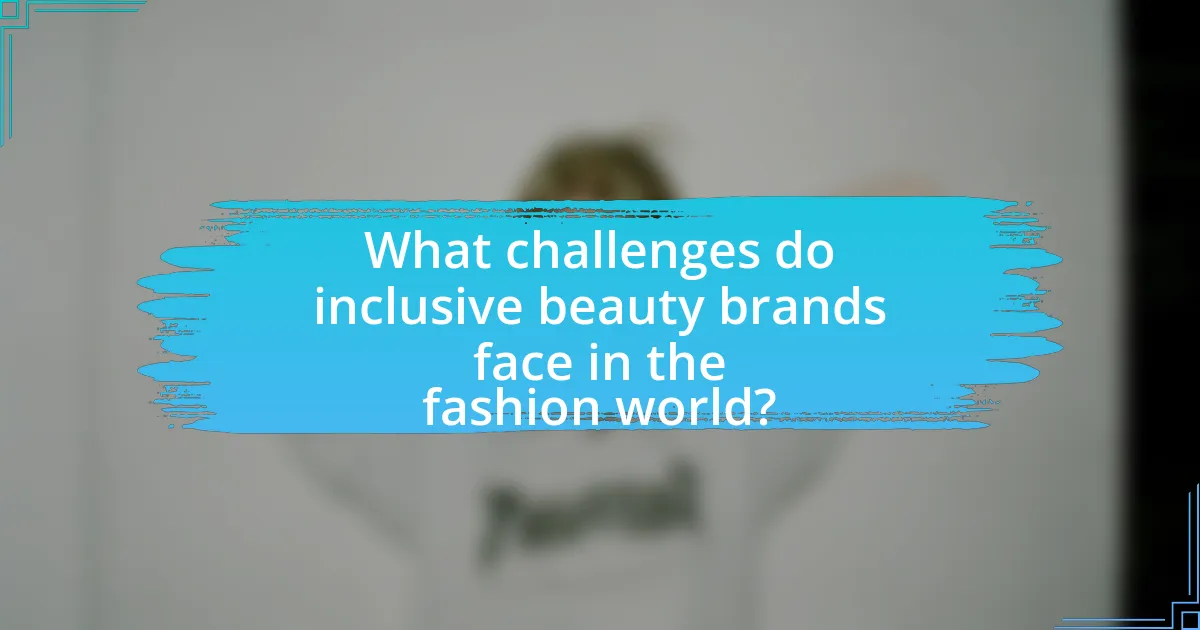
What challenges do inclusive beauty brands face in the fashion world?
Inclusive beauty brands face significant challenges in the fashion world, primarily due to market saturation and consumer skepticism. The competitive landscape is crowded with established brands that dominate market share, making it difficult for inclusive brands to gain visibility and traction. Additionally, many consumers remain skeptical about the authenticity of inclusivity claims, often questioning whether brands genuinely prioritize diversity or merely engage in performative marketing. This skepticism is supported by studies indicating that 70% of consumers are more likely to support brands that demonstrate a genuine commitment to inclusivity, highlighting the importance of transparency and accountability. Furthermore, inclusive beauty brands often struggle with supply chain limitations, as sourcing diverse products and shades can be more complex and costly, impacting their ability to compete on price and variety.
What barriers exist for inclusive beauty brands in the market?
Inclusive beauty brands face several barriers in the market, including limited access to distribution channels, high production costs, and consumer skepticism. Limited access to distribution channels restricts these brands from reaching a wider audience, as major retailers often prioritize established brands over newcomers. High production costs arise from the need for diverse product formulations and shades, which can deter investment and increase retail prices. Consumer skepticism can stem from a lack of awareness or understanding of the brand’s mission, making it challenging to build trust and loyalty. These barriers collectively hinder the growth and visibility of inclusive beauty brands in a competitive market.
How do supply chain issues affect the production of inclusive beauty products?
Supply chain issues significantly hinder the production of inclusive beauty products by causing delays in sourcing raw materials and increasing costs. For instance, disruptions in the supply chain can lead to shortages of specific pigments or ingredients essential for creating a diverse range of shades that cater to various skin tones. According to a report by McKinsey & Company, 75% of companies experienced supply chain disruptions during the COVID-19 pandemic, which directly impacted their ability to meet consumer demand for inclusive products. Consequently, brands may struggle to maintain inventory levels, resulting in limited product availability and reduced market competitiveness.
What misconceptions do consumers have about inclusive beauty brands?
Consumers often mistakenly believe that inclusive beauty brands only cater to specific demographics, such as people of color or those with disabilities. This misconception overlooks the fact that inclusive beauty brands aim to serve a diverse range of skin tones, types, and needs, promoting a broader definition of beauty that encompasses all individuals. According to a 2021 report by McKinsey & Company, the inclusive beauty market is projected to grow significantly, indicating that these brands are designed to appeal to a wide audience rather than a limited group. Additionally, many consumers think that inclusive beauty products compromise on quality or performance; however, numerous brands have demonstrated that they can deliver high-quality products while also being inclusive, as evidenced by the success of brands like Fenty Beauty, which has set industry standards for shade ranges and product efficacy.
How can inclusive beauty brands overcome these challenges?
Inclusive beauty brands can overcome challenges by prioritizing diverse representation in their marketing and product development. By actively engaging with a wide range of consumers, these brands can better understand the unique needs and preferences of different demographics. Research indicates that 67% of consumers are more likely to purchase from brands that reflect their identity, highlighting the importance of representation. Additionally, inclusive brands can invest in community outreach and partnerships with influencers from various backgrounds to enhance authenticity and trust. This approach not only fosters brand loyalty but also drives sales, as consumers increasingly seek brands that align with their values.
What strategies can brands implement to enhance inclusivity?
Brands can enhance inclusivity by implementing diverse representation in marketing campaigns and product offerings. This strategy involves showcasing models of various ethnicities, body types, and abilities, which has been shown to resonate with a broader audience. For instance, a study by the American Psychological Association found that diverse representation in advertising leads to increased consumer trust and brand loyalty. Additionally, brands can engage in community outreach and collaboration with marginalized groups to better understand their needs and preferences, ensuring that products cater to a wider demographic. By prioritizing inclusivity in their business practices, brands not only foster a more equitable environment but also tap into a growing market segment that values diversity and representation.
How can collaboration with diverse communities improve brand authenticity?
Collaboration with diverse communities enhances brand authenticity by fostering genuine connections and understanding of varied consumer needs. When brands engage with different cultural, ethnic, and social groups, they gain insights that reflect the true experiences and preferences of those communities. This approach not only helps in creating products that resonate with a broader audience but also builds trust, as consumers perceive the brand as more relatable and committed to inclusivity. Research indicates that 67% of consumers are more likely to purchase from brands that demonstrate a commitment to diversity and inclusion, highlighting the importance of authentic representation in marketing strategies.
What are the best practices for launching an inclusive beauty brand?
To launch an inclusive beauty brand, it is essential to prioritize diversity in product offerings, marketing strategies, and brand representation. This involves creating a wide range of products that cater to various skin tones, types, and cultural backgrounds, ensuring that all consumers feel represented and valued. Research indicates that 67% of consumers consider inclusivity when choosing beauty products, highlighting the importance of addressing diverse needs (NPD Group, 2020). Additionally, engaging with diverse communities during product development and marketing can foster authenticity and trust, as seen with brands like Fenty Beauty, which successfully launched with a broad foundation shade range that resonated with a wide audience.
How can brands effectively engage with their target audience?
Brands can effectively engage with their target audience by utilizing personalized marketing strategies that resonate with consumers’ values and preferences. Research indicates that 80% of consumers are more likely to make a purchase when brands offer personalized experiences, highlighting the importance of tailoring content and messaging to individual needs. Additionally, brands can leverage social media platforms to foster community engagement, as 54% of consumers prefer to interact with brands through these channels. By actively listening to customer feedback and incorporating it into product development, brands can further strengthen their connection with their audience, ensuring that their offerings align with consumer expectations and desires.
What role does feedback play in developing inclusive beauty products?
Feedback is crucial in developing inclusive beauty products as it provides insights directly from diverse consumer groups. This input helps brands understand the specific needs, preferences, and challenges faced by underrepresented demographics, ensuring that products cater to a wider audience. For instance, brands like Fenty Beauty have utilized customer feedback to expand their shade ranges, resulting in over 50 foundation shades that accommodate various skin tones. This approach not only enhances product relevance but also fosters brand loyalty among consumers who feel seen and valued.





